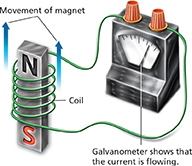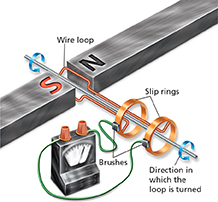The English scientist Michael Faraday (1791–1867) discovered electromagnetic induction in 1831, opening the way for many practical uses of electromagnetism.  According to Faraday's law, a voltage is induced in a conductor by a changing magnetic field. For example, changing the magnetic field through a coil of wire induces a voltage in the coil. But a current results only if the coil is part of a complete circuit.
According to Faraday's law, a voltage is induced in a conductor by a changing magnetic field. For example, changing the magnetic field through a coil of wire induces a voltage in the coil. But a current results only if the coil is part of a complete circuit.
You can see this process at work by placing a magnet inside a coil of wire attached to a galvanometer, as shown in Figure 13. If you hold the magnet still, the galvanometer will detect no current in the wire. However, if you quickly move the magnet out of the coil, the current flows briefly, and then immediately drops back to zero. Moving the magnet in and out of the coil causes an electric current first in one direction and then in the other. The same alternating current occurs if you move the coil and keep the magnet still. As long as the magnet and coil are moving relative to one another, the galvanometer will record a current.
Figure 13 According to Faraday's law, the moving magnetic field induces a current in the coil. Predicting If you increase the number of turns in the coil, and move the magnet at the same speed, will the current increase or decrease?

Generators
Moving the magnet in the coil shown in Figure 13 produces only a small amount of electric current. Most of the electrical energy used in homes and businesses is produced at large power plants using generators. A generator is a device that converts mechanical energy into electrical energy by rotating a coil of wire in a magnetic field. Electric current is generated by the relative motion of a conducting coil in a magnetic field.  The two types of generators are AC generators and DC generators. Although both types have been used, most power plants today use AC generators.
The two types of generators are AC generators and DC generators. Although both types have been used, most power plants today use AC generators.
AC Generators
Figure 14 shows a simplified AC generator. An actual generator has many loops of wire. The generator produces alternating current, in which charges flow first in one direction and then in the other direction. As you can see, the generator looks very similar to the electric motor you previously studied. While a motor converts electrical energy into mechanical energy, a generator does the opposite.
A wire coil in the generator is attached to metal bands called slip rings. The slip rings are in contact with metal brushes that are in turn attached to a circuit. As the loop of wire is rotated, perhaps by someone turning it, the magnetic field induces a current in the wire. This current is in one direction, and then when the loop turns halfway around, the current reverses direction.
Figure 14 In a simple AC generator, an external force rotates the loop of wire in the magnetic field. This induces a current in the wire.
Forming Hypotheses Could you also induce a current if you rotated the magnets instead of the wire loop?





